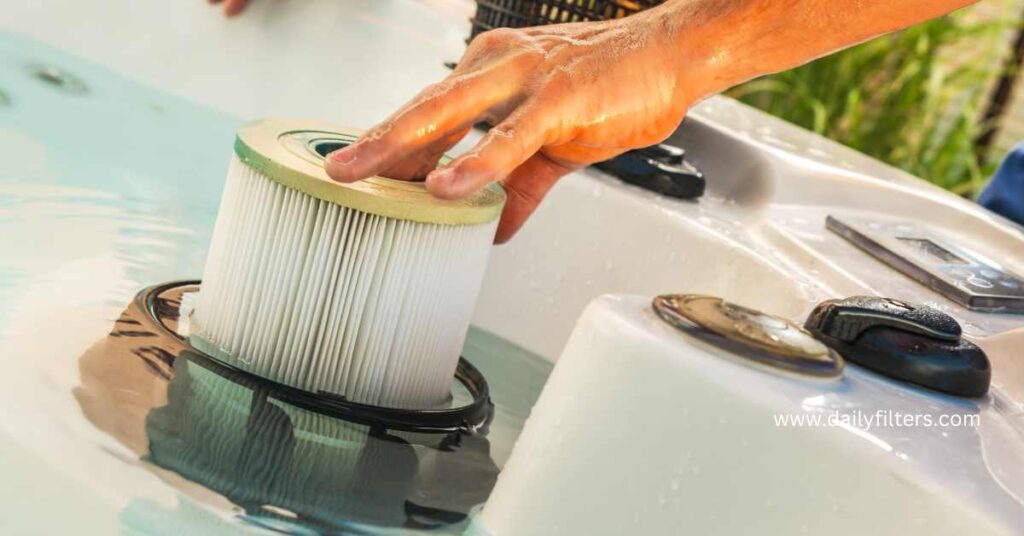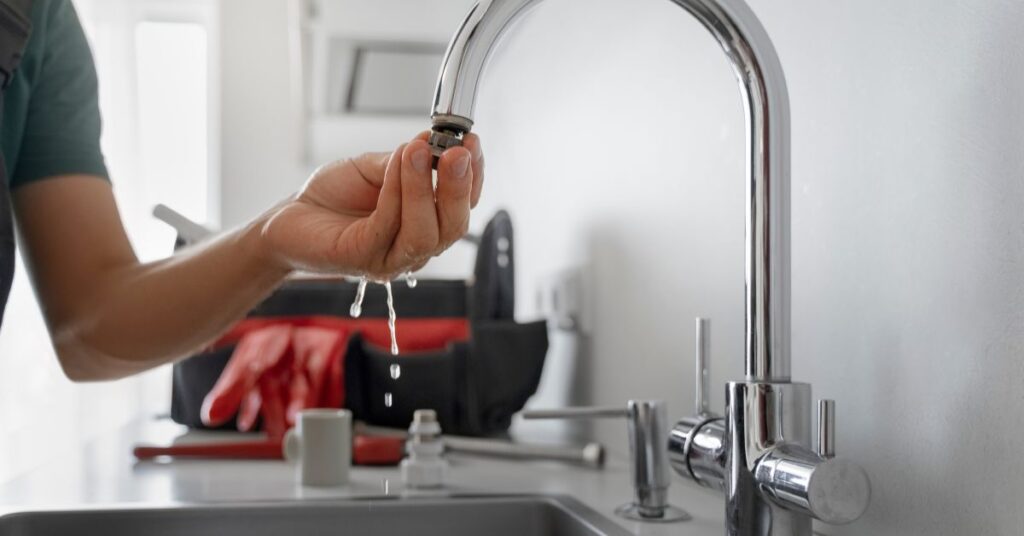If you rely on well water for your home, you may be familiar with the challenges that come with high iron content. From unsightly stains to unpleasant taste, iron can significantly impact your water quality.
This guide will explore how iron filters can solve these problems, ensuring clean, clear, and great-tasting water for your household.
Understanding Iron in Well Water
The Sources of Iron Contamination
Iron is a naturally occurring element found in soil and rock formations. As groundwater moves through these formations, it can dissolve iron, leading to its presence in well water. This process is more common in certain geographical areas with iron-rich soil or specific rock types. Additionally, older wells or those with deteriorating casings can introduce iron into the water supply.
Human activities can also contribute to iron contamination in well water. Industrial runoff, mining operations, and even the use of iron-based fertilizers can increase iron levels in groundwater. Understanding these sources helps homeowners identify potential risks and take appropriate measures to address iron contamination in their well water.
The Impact of Iron on Water Quality
High iron content in well water can have numerous negative effects on both water quality and household fixtures. One of the most noticeable impacts is the characteristic reddish-brown staining on sinks, toilets, and laundry. These stains are not only unsightly but can be difficult to remove, leading to ongoing cleaning challenges for homeowners.
Iron can also affect the taste and odor of water, imparting a metallic flavor that makes drinking and cooking unpleasant. In some cases, iron-rich water can support the growth of iron bacteria, which can create slimy buildups in pipes and fixtures. This not only affects water flow but can also lead to plumbing issues over time. Understanding these impacts underscores the importance of effective iron removal solutions.
Types of Iron in Well Water
Dissolved Iron
Dissolved iron, also known as ferrous iron or clear-water iron, is the most common form found in well water. This type of iron is completely dissolved in water and is not visible to the naked eye when first drawn. However, when exposed to air, dissolved iron oxidizes and turns into ferric iron, causing the water to take on a reddish-brown hue.
Dissolved iron is particularly challenging because it can pass through standard filters and only becomes noticeable after oxidation. This means that water may appear clear when first drawn but can still cause staining and other issues. Addressing dissolved iron often requires specialized treatment methods that can convert it to a filterable form or remove it through chemical processes.
Particulate Iron
Particulate iron, unlike its dissolved counterpart, is visible in water as small particles or sediment. This type of iron can be seen as small reddish-brown specks floating in the water or settling at the bottom of a container. Particulate iron is often the result of iron that has already oxidized before reaching your tap.
While particulate iron may seem easier to deal with due to its visibility, it can still cause significant problems. These particles can clog filters, stain fixtures, and affect the taste and appearance of water. Removing particulate iron typically involves mechanical filtration methods, often in combination with other treatment processes to ensure comprehensive iron removal.

Organic Iron
Organic iron, sometimes referred to as bacterial iron, is a less common but particularly problematic form of iron contamination. This type of iron is typically found in combination with organic matter or iron bacteria. These bacteria feed on dissolved iron in water, creating a slimy, reddish-brown substance that can coat well components, pipes, and fixtures.
Dealing with organic iron often requires a multi-faceted approach. In addition to removing the iron itself, treatment may involve disinfection to eliminate iron bacteria. This form of contamination can be particularly challenging as it often leads to recurring issues if not addressed thoroughly. Proper identification and targeted treatment are crucial for effectively managing organic iron in well water.
The Need for Iron Filtration
Health Considerations
While iron itself is not typically considered a major health hazard, high levels of iron in drinking water can lead to indirect health concerns. Excessive iron intake can cause gastrointestinal issues in some individuals, including nausea and stomach discomfort. For people with certain medical conditions, such as hemochromatosis, controlling iron intake from all sources, including water, is crucial.
Moreover, the presence of iron in water can support the growth of iron bacteria. These microorganisms, while not directly harmful to human health, can create biofilms in plumbing systems. These biofilms can potentially harbor other, more harmful bacteria, posing a secondary health risk. By removing iron from well water, homeowners can mitigate these potential health concerns and ensure safer drinking water for their families.
Aesthetic and Practical Reasons
Beyond health considerations, there are numerous aesthetic and practical reasons to remove iron from well water. The most obvious is the elimination of unsightly rust stains on fixtures, appliances, and laundry. These stains not only detract from the appearance of your home but can also lead to increased cleaning time and expenses.
Iron removal also improves the taste and odor of water, making it more pleasant for drinking and cooking. This can reduce reliance on bottled water and improve overall satisfaction with household water quality. Additionally, by preventing iron buildup in pipes and appliances, iron filtration can extend the lifespan of plumbing systems and water-using appliances, potentially saving homeowners significant money in repairs and replacements over time.
How Iron Filters Work
Oxidation and Filtration
One of the most common methods for removing iron from well water is through oxidation and filtration. This process involves converting dissolved iron (ferrous iron) into its insoluble form (ferric iron) through oxidation. Once oxidized, the iron particles can be easily filtered out of the water.
Oxidation can be achieved through various means, including aeration, chemical oxidation, or catalytic oxidation. Air injection systems, for example, introduce oxygen into the water, promoting the oxidation of iron. Once oxidized, the water passes through a filter media that traps the iron particles. This method is particularly effective for water with moderate to high levels of dissolved iron.

Ion Exchange
Ion exchange is another effective method for removing iron from well water, especially when dealing with lower concentrations of dissolved iron. This process uses a resin bed similar to those found in water softeners. As water passes through the resin, iron ions are exchanged for sodium or potassium ions.
While ion exchange can be highly effective, it’s important to note that this method may not be suitable for water with very high iron content or in the presence of organic iron. Additionally, the resin bed requires regular regeneration with a salt solution to maintain its effectiveness. Despite these considerations, ion exchange remains a popular choice for many homeowners due to its efficiency and relatively low maintenance requirements.
Manganese Greensand Filtration
Manganese greensand filtration is a specialized method that’s particularly effective for removing both iron and manganese from well water. This process uses a filter media coated with manganese oxide, which acts as a catalyst for the oxidation of iron and manganese.
As water flows through the greensand filter, dissolved iron and manganese are oxidized and then trapped by the filter media. This method requires periodic regeneration of the filter media using a potassium permanganate solution to maintain its effectiveness. Manganese greensand filtration is highly effective for water with high levels of iron and manganese, making it a popular choice for many well-water applications.
Choosing the Right Iron Filter
Assessing Your Water Quality
The first step in selecting an appropriate iron filter is to thoroughly assess your water quality. This involves testing your well water to determine the type and concentration of iron present, as well as other potential contaminants. Professional water testing can provide a comprehensive analysis of your water composition, including pH levels, hardness, and the presence of other minerals or bacteria.
Understanding your specific water quality issues is crucial for selecting the most effective treatment system. For instance, water with high levels of dissolved iron may require a different approach than water primarily containing particulate iron. Additionally, factors such as pH can significantly impact the effectiveness of certain iron removal methods. A thorough water assessment ensures that you choose a filtration system tailored to your unique water quality needs.
Considering Flow Rate and Capacity
When selecting an iron filter, it’s important to consider your household’s water usage patterns and requirements. The flow rate of your well pump and the daily water consumption of your household will determine the size and capacity of the iron filter you need. A system that’s too small may not effectively treat all the water you use, while an oversized system can be unnecessarily expensive and inefficient.
To determine the appropriate size, consider factors such as the number of people in your household, the number of water-using appliances, and peak water usage times. It’s often recommended to choose a system that can handle your peak flow rate to ensure adequate water pressure and supply during high-demand periods. Consulting with a water treatment professional can help you accurately assess your flow rate and capacity needs.

Installation and Maintenance
Professional vs. DIY Installation
The installation of an iron filter system can vary in complexity depending on the type of system chosen and your existing plumbing configuration. While some homeowners with plumbing experience may opt for DIY installation, professional installation is often recommended to ensure proper setup and optimal performance.
Professional installation offers several advantages, including proper sizing and placement of the system, correct integration with your existing plumbing, and adherence to local building codes. Professionals can also provide valuable advice on system operation and maintenance. However, if you choose to install the system yourself, be sure to carefully follow manufacturer instructions and consider consulting with a professional for any complex aspects of the installation.
Regular Maintenance Requirements
To ensure the longevity and effectiveness of your iron filter, regular maintenance is essential. The specific maintenance requirements will depend on the type of system you have installed but generally include tasks such as backwashing, replenishing filter media, and checking for any signs of wear or malfunction.
For systems using chemical oxidation, regular replenishment of oxidizing agents is necessary. Ion exchange systems require periodic regeneration of the resin bed with a salt solution. It’s important to follow the manufacturer’s recommended maintenance schedule and procedures to keep your system operating at peak efficiency. Regular water testing can also help you monitor the effectiveness of your iron filter and identify any changes in water quality that may require adjustments to your treatment approach.
Benefits of Iron-Free Water
Improved Appliance Efficiency
One of the significant benefits of removing iron from well water is the improved efficiency and longevity of household appliances. Iron buildup can accumulate in pipes, water heaters, dishwashers, and washing machines, reducing their efficiency and potentially leading to premature failure. By eliminating iron, you protect these appliances from damage and ensure they operate at peak performance.
Iron-free water also means less scale buildup in appliances like coffee makers and kettles. This not only extends the life of these smaller appliances but also maintains their energy efficiency. In the long run, this can lead to significant savings on appliance repairs and replacements, making iron filtration a wise investment for homeowners relying on well water.
Enhanced Water Quality for Daily Use
Perhaps the most noticeable benefit of iron-free water is the improvement in overall water quality for daily use. Without iron, water tastes better and is more pleasant for drinking and cooking. This can reduce reliance on bottled water, saving money and reducing plastic waste. Showering and bathing in iron-free water is also more enjoyable, as it doesn’t leave a residue on skin and hair.
Iron removal also eliminates the issue of stained laundry. Clothes washed in iron-free water come out cleaner and brighter, without the risk of rust stains or discoloration. This not only improves the appearance of your clothing but can also extend the life of your garments. Overall, the enhanced water quality resulting from iron filtration contributes to a more comfortable and enjoyable home environment.
Environmental Considerations
Eco-Friendly Filtration Options
As environmental awareness grows, many homeowners are looking for eco-friendly options for iron filtration. Some systems now use natural oxidation processes or environmentally safe filter media to remove iron without relying heavily on chemicals. Air injection systems, for example, use oxygen to oxidize iron, reducing the need for chemical oxidants.
When choosing an iron filter, consider options that minimize water waste and use sustainable materials. Some advanced systems are designed to reduce backwash frequency, conserving water in the process. Additionally, look for filters with components that can be recycled or easily disposed of without harming the environment. By choosing eco-friendly filtration options, you can address your water quality issues while also being mindful of your environmental impact.
Reducing Chemical Usage
Traditional iron removal methods often rely on chemical oxidants or salt-based regeneration processes. However, newer technologies are emerging that can effectively remove iron with reduced chemical usage. Catalytic filtration systems, for instance, can oxidize iron without the need for chemical regeneration, making them a more environmentally friendly option.
For those using systems that do require chemicals, proper management and disposal of these substances are crucial to minimize environmental impact. Consider systems that optimize chemical usage through precise dosing or regeneration on an as-needed basis rather than on a fixed schedule. By reducing chemical usage in iron filtration, you not only lower your environmental footprint but also decrease ongoing maintenance costs and potential chemical exposure in your home.
Troubleshooting Common Issues
Identifying System Failures
Even with proper maintenance, iron filtration systems can occasionally experience issues. Common signs of system failure include a return of iron staining, changes in water color or taste, or decreased water pressure. It’s important to regularly monitor your water quality and system performance to catch any problems early.
If you notice any signs of system failure, start by checking basic components like power supply, valve settings, and filter media condition. Ensure that backwash cycles are occurring as scheduled and that any chemical feed systems are functioning correctly. Keep a log of system performance and maintenance activities to help identify patterns or recurring issues. If problems persist, it may be necessary to consult with a water treatment professional for more in-depth troubleshooting and potential repairs.
When to Seek Professional Help
While many minor issues with iron filtration systems can be addressed through routine maintenance or simple troubleshooting, there are times when professional assistance is necessary. If you experience sudden or significant changes in water quality, unusual noises from your system, or if basic troubleshooting doesn’t resolve the issue, it’s time to call in an expert.
Professional water treatment specialists have the tools and expertise to diagnose complex problems and recommend appropriate solutions. They can perform comprehensive water tests, inspect system components for wear or damage, and make necessary adjustments or repairs. Regular professional servicing can also help prevent major issues and extend the life of your iron filtration system. Don’t hesitate to seek professional help if you’re unsure about any aspect of your system’s performance or maintenance.
Future Trends in Iron Filtration
Emerging Technologies
The field of water treatment is constantly evolving, with new technologies emerging to address iron contamination more effectively and efficiently. One promising area is the development of advanced oxidation processes that can remove iron and other contaminants simultaneously. These methods often use combinations of ozone, ultraviolet light, or hydrogen peroxide to provide powerful oxidation without the need for chemical additives.
Another trend is the integration of smart technology into iron filtration systems. These smart-systems can monitor water quality in real-time, adjusting treatment processes automatically for optimal performance. Some systems even offer remote monitoring and control capabilities, allowing homeowners to manage their water treatment from their smartphones. As these technologies continue to develop, we can expect to see more efficient, user-friendly, and environmentally sustainable iron filtration solutions in the future.
Advancements in Filter Media
Research into new filter media is also driving advancements in iron filtration. Scientists are exploring materials with enhanced iron removal capabilities that require less frequent regeneration or replacement. Some of these new media combine multiple treatment processes in a single material, offering more comprehensive water treatment in a compact system.
Nanotechnology is another area of innovation in filter media development. Nanostructured materials can provide increased surface area for iron adsorption, potentially improving filtration efficiency and capacity. These advanced materials may also offer benefits like antimicrobial properties or the ability to remove multiple contaminants simultaneously. As these new filter media become more widely available, homeowners can look forward to more effective and convenient iron removal options for their well water systems.
FAQs
How often should I maintain my iron filter?
Most systems need maintenance every 3-6 months. Check your manufacturer’s guidelines for specific instructions.
Can an iron filter remove other contaminants besides iron?
Some iron filters can also remove manganese and sulfur. For other contaminants, you may need additional treatment systems.
How long do iron filters typically last?
With proper maintenance, a good quality iron filter can last 10-15 years. The filter media may need replacement every 3-5 years.
Will an iron filter affect my water pressure?
A properly sized iron filter should not significantly impact water pressure. If you notice a drop, consult a professional.
Final Thought
Iron filters are a vital investment for homeowners with well water high in iron content. These systems not only improve water quality but also protect plumbing and appliances from damage. While choosing and maintaining an iron filter requires some effort, the benefits of clean, clear, and great-tasting water far outweigh the costs.
As technology advances, we can expect even more efficient and user-friendly solutions for iron removal in the future. By addressing iron issues, you’re not just solving a water problem – you’re enhancing your overall quality of life at home.

